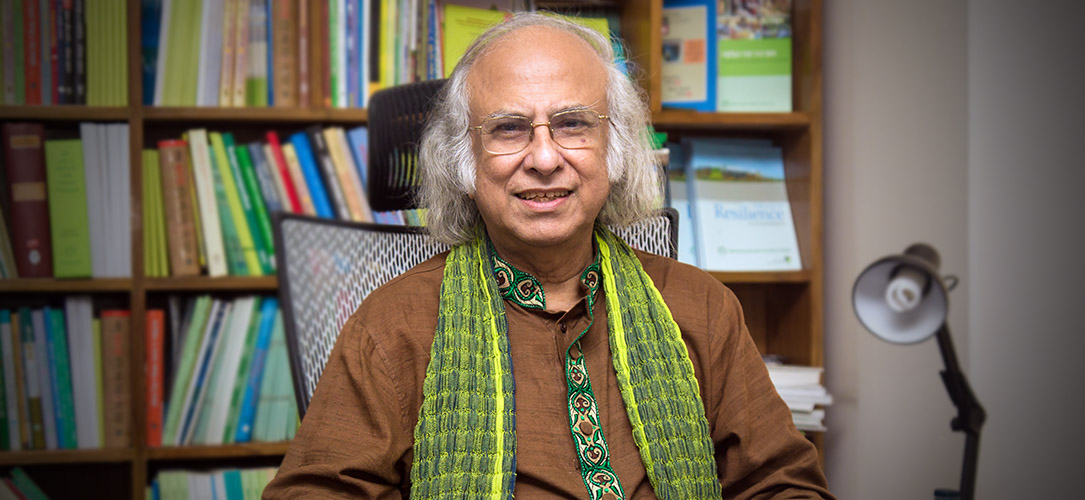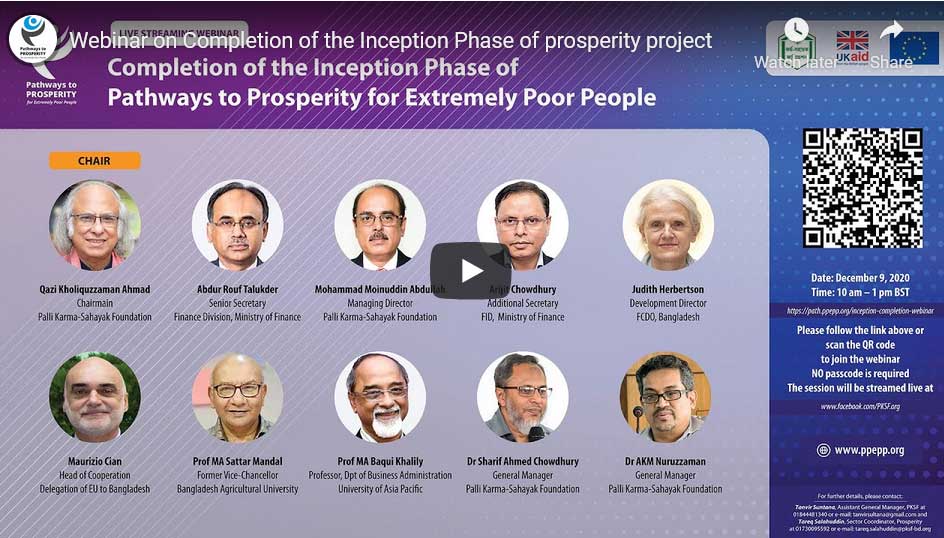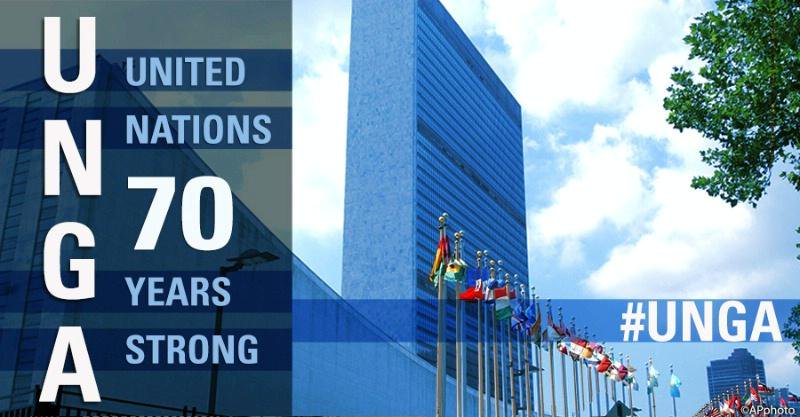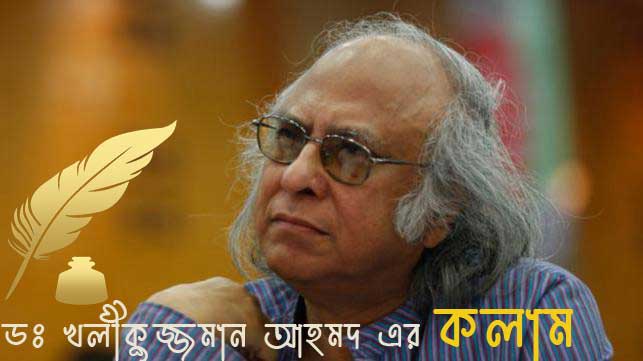Interview of Dr. Qazi Kholiquzzaman Ahmad, Chairman, Dhaka School of Economics
By ICE Business Times (Posted on August 27, 2017)
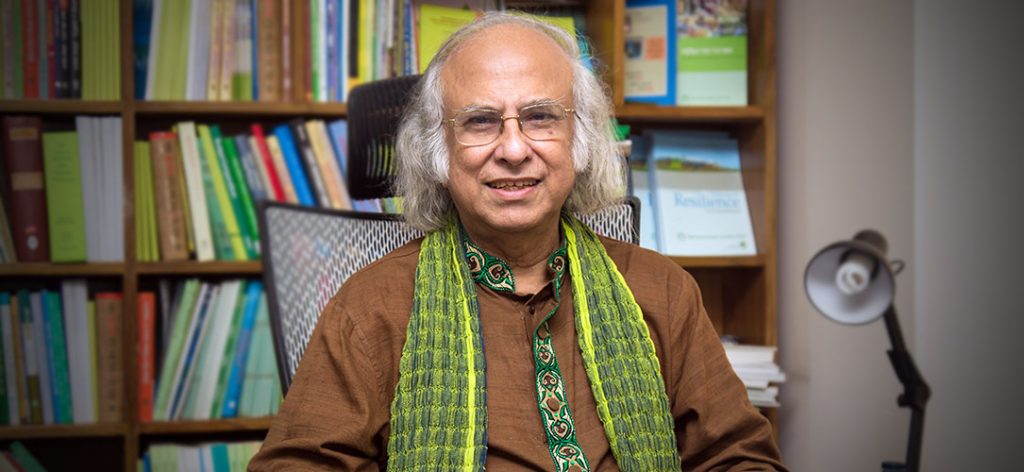
Dr. Qazi Kholiquzzaman Ahmad is a leading Bangladeshi economist, development thinker and activist. He is also the Chairman of the Palli Karma-Sahayak Foundation (PKSF), which is the largest rural development funding, skill development and management support agency in Bangladesh.
Kholiquzzaman is also the Chairman of the Dhaka School of Economics (DScE), a Constituent Institution of the University of Dhaka, devoted to post-graduate studies in economics and related subjects. He completed his Bachelors and Masters in Economics from the University of Dhaka and later he went to the London School of Economics on a national merit fellowship and obtained his MPhil and PhD degrees. He was active in promoting Bangladesh’s nationalist aspirations during the 1960s and worked in the Planning Cell of Bangladesh Government-in-Exile during the War of Liberation of Bangladesh in 1971.
He spent 23 years in the Bangladesh Institute of Development Studies (BIDS) and its preceding organization, Pakistan Institute of Development Economics (PIDE), having been a Research Director for a number of years. He left BIDS in 1987 and then worked as the Chairman of Bangladesh Unnayan Parishad (BUP), which he helped set up in 1980. He left BUP on taking over as chairman of the Governing Body of PKSF in November 2009.
Through the course of his career, Qazi Kholiquzzaman Ahmad has received numerous accolades for his work including Ekushey Padak and MTC Global Life Time Achievement Award by MTC Global—A Global Think Tank in Higher Education, Bangalore, India. He was a member of the team that contributed to the Award of Nobel Peace Prize to the UN Intergovernmental Panel on Climate Change (IPCC) in 2007. His publications, research reports and unpublished papers include 38 books and over 250 articles. He is also a well-known expert on water and climate change issues.
Historically Bangladesh started as a command economy but now it grows as a market led economy. As you are a keen observer of this economic development, how would you describe the country’s evolution over the years?
The Bangladesh Awami League, the political party that led the Independence movement had in its agenda the promotion of people-centered development in independent Bangladesh. Once Liberation was achieved in December 1971, the Awami League Government took steps in that direction. The industries abandoned by the Pakistani owners and those owned by Bangladeshis were nationalized. In particular, jute manufacturing, textile, and sugar industries were brought under State ownership. Banking and insurance, water transportation sectors were also nationalized. Primary schools were nationalized.
However, an apparent mistake was made in the management of the nationalized Bangladeshi owned industries in that the former owners were given the responsibility of management in many cases. Of course, this perhaps had to be done per force, because of critical shortage of qualified industrial management personnel in the country. The former owners in many cases did not take the job of managing the industries seriously. Some of them in fact harmed the industries by using various means to make money themselves. That led to a decline in the efficiency and profitability of the industries.
The jute manufacturing industry was not in reality profitable, even during pre-independence period. However, the owners made profits even when the prices charged were below the costs of production. This was possible because of the ‘export bonus scheme’, which allowed the exporters to buy at official exchange rate a part of the foreign exchange earned and sell that to prospective foreign exchange purchasers. There was a high premium in the private sale of foreign currency, sometimes 150% or more. In the late 1960s, 30% of the export earnings from jute goods was allowed to be bought under the export bonus scheme. In fact, no export bonus was allowed for raw jute export until very late 1960s, when only a 10% export bonus was introduced. As a result, price of raw jute was dampened so that the jute manufacturing sector could buy raw jute at low prices. This, in fact, meant a transfer of income from jute growers (Bangladeshis) to jute manufactures (mostly West Pakistanis).
Since the benefits were easy to come by, because of the policy framework, the jute manufacturing industry was inherently inefficient in the Pakistani period although significant profits were being made by the owners. The management and other problems faced after Liberation further eroded the efficiency and profitability of the jute manufacturing industry. Later, Bangladeshi owned factories were returned to their owners but the whole sector remained problematic. As a result, many factories were shutdown. In fact, the Government policy up to mid-1990s was to contract the industry because it was determined that the industry had no future. The World Bank assisted the Government in that process. The largest jute mill, The Adamjee, was shutdown in 1994, without taking stock of its assets, liabilities and properties and also the plight of the employees.
Currently, there seems to be brighter prospects of the jute sector, largely because of increased environmental awareness. The synthetic products that replaced the jute goods are environmentally damaging and climate change-inducing. On the other hand, jute is bio-degradable. Currently, the Government of Bangladesh is trying to revive the jute sector and there seems to be some progress already and prospects are enlarging. Some of the jute manufacturing factories are in the government sector and others are in the private sector and the overall policy is to support better performance by both. The government policy is also to promote quality raw jute production, ensuring quality seed and jute retting facilities.
In the meantime, the Ready Made Garments (RMG) sector has developed starting in the mid-1980s. Currently, the RMG and hosiery exports account for 75-80% of the total export earnings. It was exactly the same in relation to jute and jute goods exports in the 1970s. One hopes that the jute sector will again expand and export earnings will also increase while the RMG sector will continue to flourish. However, it is also important that efforts should be intensified to diversify exports, as currently the total export earnings virtually depend on 5 or 6 items or groups of items.
However, the philosophy of social control of industries and establishment of people-centric development has been abandoned. The process started following the heinous act of killing Bangabandhu in August 1975. Importance was then shifted to the market economy and gradually the industries were being denationalized. Eventually, the approach of people-centricism was abandoned and capital-centricism became the ruling paradigm. This process started with structural adjustment (privatization, deregulation, and minimum government), initiated in the late 1980s but particularly carried forward in the early 1990s. As a result, poverty and disparity increased steeply.
The ruling paradigm is still market-based. But, over the last decade or so, the emphasis on poverty reduction and employment generation for the downtrodden have been receiving significant state attention. Thus, poverty has been reduced sharply to 24% and extreme poverty to 12.9%. Infant, child and maternal mortality rates have declined sharply. At the same time, economic growth has been over 6% for seven or eight years, rising up to 7.24% in the fiscal year 2016-17. Thus, Bangladesh is now doing very well in terms of both economic growth and social progress which is recognized within the country and internationally. However, given the size of the population, poverty ratio of 24% translates into about 40 million and extreme poverty ratio of 12.9% into about 20 million. Thus, the number of the downtrodden remains high. On top of that, natural disasters such as cyclones, floods, river erosions, and salinity ingress are increasing, as a result of climate change, in terms of both frequency and devastation, causing many non-poor to become poor and many poor to become extremely poor and many extremely poor to become destitute. Moreover, damages to and destruction of infrastructure and other assets imply huge economic costs. The impacts of climate change are a very difficult area to address. However, the Government has developed policies and strategies and using its own resources as much as possible to address climate change impacts. At the same time, internationally, Bangladesh is very active in, for example, calling upon the developed world and large greenhouse gas (GHG) emitters to sharply reduce their emissions, with a view to arresting and reversing the now worsening process of climate change and also upon the international community to assist the vulnerable countries including Bangladesh with finances and technologies to address climate change.
As an expert on water-related issues, what are your thoughts on the current situation in Bangladesh in that regard?
Per capita water availability in Bangladesh on an annual basis is still robust. It is about 7,500 cubic metres (cm3), while in India and Pakistan it is only 1,500 to 2,000 cm3. But, Bangladesh’s problem is the distribution, which is highly skewed both spatially and seasonally. For example, 80% of the total annual water run-off in Bangladesh occurs during the monsoon months while 20% in the dry season. The dry season is from 1 January to 31 May, but particularly difficult months are March and April. Thus, in the monsoon, the water is abundant and, in fact, can be and on occasions is a serious threat to life and property because of flooding, while in the dry season acute shortages of water, more so in north and western parts of Bangladesh, is also a serious problem.
The pattern of rainfall is shifting and changing as a result of climate change. That is, often, when it is supposed to rain it does not and when it not supposed to it does. At times, it becomes very heavy causing widespread inundations. For example, this year, flash flood in haors occurred about a month earlier then normal and became so devastating that the entire rice crop in those areas was lost, many people were displaced and many rendered homeless; and the household economies of the affected people were seriously affected. On the hill of that, a major flood has visited many parts of the country, which is ongoing. Thus, many more people are severely affected; a total of 5 to 6 million is being mentioned. This, i.e. major flood, is a life and property threatening face of water.
Another devastating problem is water-logging in various parts of the country as a result of blockages created by fishing gher and also unplanned and unauthorized structures. Water-logging is also a serious problem in big cities like Dhaka and Chittagang, caused as a result of poor drainage systems and constructions blocking water flows.
Too little water in the dry season is another devastating face of water, as critical water shortages damage crop and other economic activities as well as livestock and poultry. In fact, due to non-availability of adequate clean drinking water, people face health hazards.
In the coastal areas and in islands, salinity is a serious problem. People living in those areas suffer from a serious lack of clean drinking water. In these areas, about one-third to 40% of the country’s population lives. Clean water is not available in most of these areas; for that one has to dig 900 or 1,000 feet or even deeper underground. In some places, deep tubewells are set up to provide access to clean drinking water for the people. Desalination plant is also being established at places. But, the problem is so gigantic that huge numbers of people still keep suffering from a serious lack of clean drinking water and water for household uses.
In relation to salinity ingress, the polders were built in the 1960s. At that time a height of 5 feet was sufficient. But now the sea level is rising and tide is penetrating more and more inside of the country, pushing salinity further and further inland. The height of the polders needs to be raised but this is very expensive. Moreover, the damaged/broken embankments and polders should also be repaired. Some years ago, it was estimated that about US$10 billion would be needed to renovate polders and embankments, raising their heights appropriately. This is a huge amount of money which Bangladesh cannot mobilize at a time. What is, therefore, necessary is to prioritize the activities on the basis of proper assessment of improvements that may be created and strategic importance; and take actions on that basis, given the availability of resources.
One particular problem of water management in Bangladesh is that 92% of the annual run-off in Bangladesh comes from upstream in India mostly and only 8% is generated from rainfall within the country. Regional/bilateral cooperation is, therefore, a very important issue in the context of water management in Bangladesh. During the rainy season, advance information is necessary from upstream for forecasting floods and taking steps to minimize damages and losses. In the dry season, however, water sharing is the issue. But, between India and Bangladesh there is water sharing arrangement only in one river, the Ganges, while a total of 54 rivers come down to Bangladesh from India. Even the Ganges Treaty will expire in another 9 years, i.e. in 2026. Thus, cooperation in transboundary water management remains extremely limited, although Bangladesh has been trying hard to promote cooperation in this field with India and other coriparians.
A good Water Policy was adopted in 1999; a Water Management Plan which was drafted in 2001 and adopted in 2004; and a Water Act was enacted in 2013. These policy and strategy documents provide management guidelines for involving all stakeholders including water users. But, often the implementation is poor. It is noticed that there is also often complacency at the top management level or there is a serious lack of supervision and monitoring, while negligence and failures to act on time often occur at the operational level. Also, there is corruption that siphons away funds, and the quality of the work done is very poor. Moreover, often maintenance budget is not provided for, so that the structures established are poorly maintained or not maintained at all and crumble quickly.
What are the future challenges of our growing economy?
As I mentioned earlier, Bangladesh has made notable progress in recent years on both economic and social fronts. Now is the time to consolidate the achievements and accelerate and upgrade future socio-economic progress. To achieve that, what needs to be done is to identify and manage the challenges faced. It’s just like an airplane, which stops on the track before taking off to check if everything is in order, Bangladesh, at its stage of development, should check on the challenges that may jeopardize the jump to a higher trajectory of development and accelerated progress along that pathway and resolve them. Let me mention some of the major ones.
Human capability shortages at all levels of society and economy is a serious problem in the context of moving on to an accelerated and sustainable development pathway. The Government of Bangladesh has adopted a progressive National Education Policy (2010) and a Skill Development Policy (2011). There are also other programmes for skill development. But, the gaps are huge and much more focused attention and programmes are needed, which must be implemented efficiently and effectively.
Second, corruption is pervasive and this problem is much talked about. Here also much more focused attention is necessary because socio-economic progress is stunted to a significant extent by corruption.
Third, political stability is an important factor behind sustainable and accelerated progress. Since all political parties and others have a stake in the nation’s progress, all must come together to establish a basic political and social stability for the nation to move forward and people to improve their living and social conditions. One other challenge is terrorist activities. In this context, Bangladesh is doing tremendously well in containing terrorism. But, continued vigilance and actions are necessary to stabilize and further improve the situation.
Socio-economic disparity (among economic classes and regions, and gender related) is a serious challenge which is well known and needs stronger actions to be sustainably reduced. Also, for a smooth social progress involving all segments of population, it is essential to address the social menaces such as child marriage, child labor, violence against women, drug addiction, and tobacco consumption.
Can human-centric development be achieved through microcredit?
Microcredit, a small amount of credit, repayable in weekly installments over a year is like a holding an operation. The poor people taking microcredit try to survive but they generally remain afflicted with poverty. Poverty cannot be reduced with microcredit alone, certainly not on a sustainable basis. In fact, for human development, people, particularly the downtrodden, have to be empowered through education, skill training, and healthcare services. They should then be facilitated to find jobs or to establish economic activities of their own. In PKSF, we have changed the approach. The PKSF works through its Partner Organizations (POs), which are authorized to provide credit up to Tk. 1,000,000 (ten lakh or one million), taking the actual circumstances of the investors and merit of their proposals into account. The extremely poor cannot use much money. They are provided with amounts that they can use properly and as they progress, the amount of credit is also increased. But, no credit is provided without first providing skill training to the recipients. They are also facilitated to access appropriate technology and assisted in the marketing of their products. The approach is holistic and the credit provided is called ‘appropriate credit’. The amount needed for the proposed activities of the borrowers, if acceptable, is fully met if it is not more than Tk. 1,000,000. Also, the repayment of a loan is now often monthly, quarterly, or even after longer periods, depending on the types of activities supported. Under this approach, people are turning around quickly and moving on to a beyond poverty sustainable development pathway.
We have observed success in many segments, but which areas should we prioritize?
Now that Bangladesh has embarked on the UN adopted sustainable development pathway, it is essential that everybody is included in the process, and nobody excluded. This essentially require a particular focus on the downtrodden in terms of their capability development and access to employment or other income earning sources. It is also necessary that all stakeholders are involved both in promoting sustainable development and benefiting from it equitably. Therefore, policy and institutional congruence is essential, keeping the socio-economic inclusion requirement in sharp focus.
In the process, all sectors of the economy also need to be promoted on the basis of their respective potentials. Agriculture still remains the main stay of Bangladesh economy. Although, given the wide expansion of the service sectors, agriculture contributes about 15% of the GDP, and it still accounts for 47% of total national employment directly and many more indirectly. It also provides food, raw materials and market for the products of other sectors. Agriculture, therefore, has to be given a high priority. Agriculture of course includes crop, fishery, and livestock sub-sectors. The Government of Bangladesh recognizes the importance of agriculture and has been taking steps to promote all the agricultural sub-sectors. More and more research and development activities would be necessary to ensure sustainable development of agriculture, particularly in view of the adverse impacts of climate change on agriculture and loss of agricultural land due to other uses and increasing river erosion and salinity ingress in the wake of climate change.
What about industrialization?
However, sustainable development is not possible on the basis of only agricultural growth. Rather it requires industrialization. In rural areas, micro-enterprises have great potential, which should be exploited through necessary support mechanisms.
The RMG sector is doing well. Also, the pharmaceutical sector is making much headway. Leather industry has significant prospect. The ICT sector has tremendous growth potential. The prospect of jute and jute goods is increasing, given that these are bio-degradable, while the alternative synthetic products are environmentally damaging and climate change inducing. Therefore, these potential sectors need attention. Also, attention should be given to other potential industries. The Government has taken steps to establish Special Economic Zones (SEZs) to promote industrialization. This is making good progress. It is necessary to ensure effective implementation of all the SEZs.
The policy planning for all these activities should be people-centric so that the downtrodden are supported to find jobs or set up enterprises.
Source Link: http://ibtbd.net/dr-qazi-kholiquzzaman-ahmad-chairman-palli-karma-sahayak-foundation-pksf/
